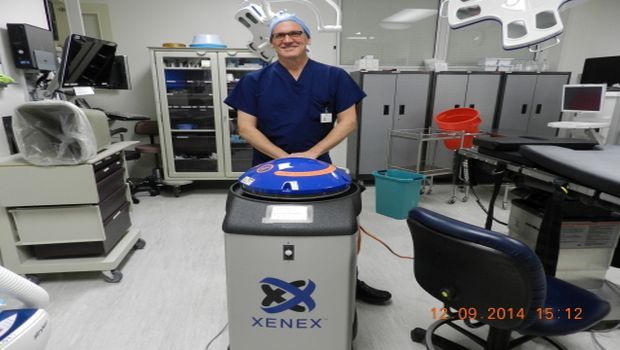St. Cloud Surgical Center is First ASC in U.S. to Utilize Xenex Germ-Zapping Robot to Disinfect ORs
Xenex Disinfection Services announces that St. Cloud Surgical Center is the first ambulatory surgery center (ASC) in the U.S. and the first healthcare facility in St. Cloud to utilize a Xenex germ-zapping robot to enhance patient safety by destroying the deadly pathogens that can cause healthcare-associated infections (HAIs). St. Cloud Surgical Center is using Xenex’s full-spectrum UV disinfection system to disinfect its surgical suites daily.


St. Cloud Surgical Center is the first ambulatory surgery center (ASC) in the U.S. and the first healthcare facility in St. Cloud to utilize a Xenex germ-zapping robot to enhance patient safety by destroying the deadly pathogens that can cause healthcare-associated infections (HAI). St. Cloud Surgical Center is using Xenex's full-spectrum UV disinfection system to disinfect its surgical suites daily. Pictured is Dr. Joseph P. Nessler, orthopedic surgeon and St. Cloud Surgical Center physician partner.
Xenex Disinfection Services announces that St. Cloud Surgical Center is the first ambulatory surgery center (ASC) in the U.S. and the first healthcare facility in St. Cloud to utilize a Xenex germ-zapping robot to enhance patient safety by destroying the deadly pathogens that can cause healthcare associated infections (HAI). St. Cloud Surgical Center is using Xenex’s full-spectrum UV disinfection system to disinfect its surgical suites daily.
“We decided to use the Xenex robot because we want to provide patients with the highest level of safety and environmental cleanliness during surgical procedures at St. Cloud Surgical Center,” says Dr. Joseph P. Nessler, orthopedic surgeon and St. Cloud Surgical Center physician partner.
The Xenex pulsed xenon UV disinfection system is the fastest, safest and most effective method for the advanced cleaning of healthcare facilities, scientifically proven to reduce all major classes of microorganisms, including Clostridium difficile (C. diff), norovirus, influenza and methicillin-resistant Staphylococcus aureus (MRSA). At St. Cloud Surgical Center, the easily portable robot is used in the surgical suites daily after terminal cleaning of the operating room (OR) has taken place. Taking only 5 to 10 minutes, the robot is utilized to disinfect rooms before and after total joint procedures, as well as after any procedure involving a patient known to have a dangerous infection.
“Patient safety is our top priority,” says Julie Tonsager, OR team leader at St. Cloud Surgical Center. “We clean the rooms with traditional cleaning methods, but there are always nooks and crannies that are hard to reach. And, the germs are getting tougher and so it was important for us to take the battle against infections to the next level to ensure our patients receive the best care -- and the Xenex robot allows us to do just that. We evaluated many different options for room disinfection and after careful analysis we chose the Xenex robot because of its proven results.”
The Xenex germ-zapping robot works by pulsing xenon, an inert gas, at high intensity in a xenon ultraviolet flashlamp. This produces broad spectrum ultraviolet C (UVC), which penetrates the cell walls of microorganisms. Their DNA is instantly fused so that they are unable to reproduce or mutate, effectively killing them on surfaces and in the air without contact or chemicals.
Source: Xenex Disinfection Services
Vet IP Roundtable 2: Infection Control and Biosecurity Challenges in Veterinary Care
March 31st 2025Veterinary IPs highlight critical gaps in cleaning protocols, training, and biosecurity, stressing the urgent need for standardized, animal-specific infection prevention practices across diverse care settings.
Invisible, Indispensable: The Vital Role of AHRQ in Infection Prevention
March 25th 2025With health care systems under strain and infection preventionists being laid off nationwide, a little-known federal agency stands as a last line of defense against preventable patient harm. Yet the Agency for Healthcare Research and Quality (AHRQ) is now facing devastating cuts—threatening decades of progress in patient safety.
From Shortages to Security: How Reusable Health Care Textiles Can Transform Infection Prevention
March 7th 2025Reusable health care textiles enhance infection prevention, reduce waste, and strengthen supply chains. Hygienically clean textiles offer a sustainable, cost-effective alternative to disposable PPE, ensuring patient safety and environmental responsibility.